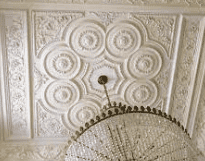If you are looking for ways to make your home more artistic and attractive there is one medium that can provide the answer. Decorative plaster was, at one time, the benchmark for a stately home and was evident in many major and minor Victiroan homes, lasting into the 1920s. The art was lost to some degree as the age of Modernism that came out of the late 1940s, 50s and 60s favoured a less baroque and more clinical approach to house design and interiors. However, the desire and art of the decorative plaster work has never truly gone away and as we start to appraise the Victorian and Edwardian style and architecture many are asking if there isn;t a case to bring it back into the modern home. If you think you’d like to wake up your door frames and light fittings, or plaster work in general, then companies like Pure Plasterers, a Plasterer Cheltenham operation, would be a great starting point to see what’s available.
Plaster is a simple formula, it’s just gypsum, lime cement and water. However, it is one of the most versatile building substances that humans have discovered and utilised. Not only does it cover cracks and unsightly holes it leaves a smooth finish that can be painted and sanded. As it is partially liquid it can be poured into molds and then mounted onto walls and around doors. This was the height of fashion and style when creating the Stately home. The development of natural rubber meant that artisan designers were able to create greater and more intricate molds to cast the plaster in.
The most popular designs were taken from the classical world. The Victorians, with an empire of their own, looked to the Doric and Ionic architecture of the Greeks and Romans, who they wanted to emulate. If you didn’t have a classical cornice over your living room and dining room doors then you weren’t seen as doing very well.
You don’t need to go to the extremes of the Victorians. Less can certainly be more. One feature that is quite delightful and proving to be popular is the covering of light fittings with an ornate and stylish ceiling mount. Edwardian style coving is also a popular choice. It’s simple but very effective and proves a nice finish to the corners and edge of the walls to the ceiling.


